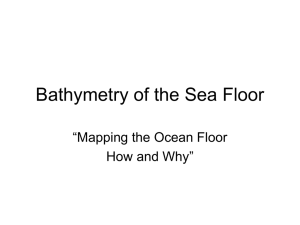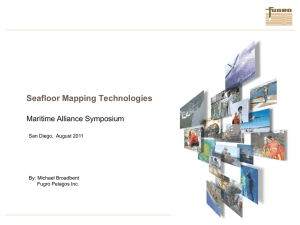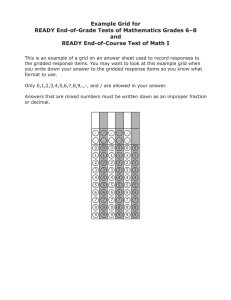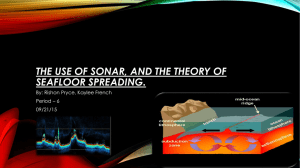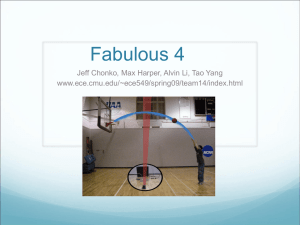RECONSTRUCTION OF SEAFLOOR SURFACE MODELS BY SHAPE FROM SHADING
advertisement
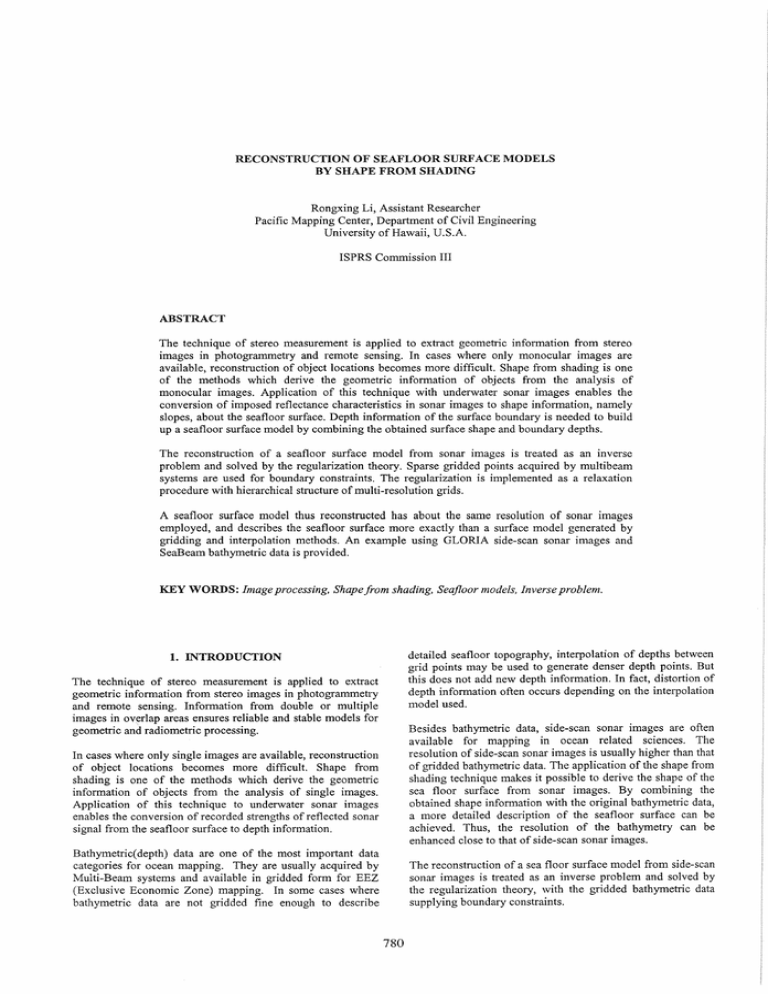
RECONSTRUCTION OF SEAFLOOR SURFACE MODELS BY SHAPE FROM SHADING Rongxing Li, Assistant Researcher Pacific Mapping Center, Department of Civil Engineering University of Hawaii, U.S.A. ISPRS Commission III ABSTRACT The technique of stereo measurement is applied to extract geometric information from stereo images in photogrammetry and remote sensing. In cases where only monocular images are available, reconstruction of object locations becomes more difficult. Shape from shading is one of the methods which derive the geometric information of objects from the analysis of monocular images. Application of this technique with underwater sonar images enables the conversion of imposed reflectance characteristics in sonar images to shape information, namely slopes, about the seafloor surface. Depth information of the surface boundary is needed to build up a seafloor surface model by combining the obtained surface shape and boundary depths. The reconstruction of a seafloor surface model from sonar images is treated as an inverse problem and solved by the regularization theory. Sparse gridded points acquired by multibeam systems are used for boundary constraints. The regularization is implemented as a relaxation procedure with hierarchical structure of multi-resolution grids. A seafloor surface model thus reconstructed has about the same resolution of sonar images employed, and describes the seafloor surface more exactly than a surface model generated by gridding and interpolation methods. An example using GLORIA side-scan sonar images and SeaBeam bathymellic data is provided. KEY WORDS: Image processing, Shape from shading, Seafloor models, Inverse problem. detailed seafloor topography, interpolation of depths between grid points may be used to generate denser depth points. But this does not add new depth information. In fact, distortion of depth information often occurs depending on the interpolation model used. 1. INTRODUCTION The technique of stereo measurement is applied to extract geomenic information from stereo images in photogrammetry and remote sensing. Information from double or multiple images in overlap areas ensures reliable and stable models for geometric and radiomenic processing. Besides bathymetric data, side-scan sonar images are often available for mapping in ocean related sciences. The resolution of side-scan sonar images is usually higher than that of gridded bathymetric data. The application of the shape from shading technique makes it possible to derive the shape of the sea floor surface from sonar images. By combining the obtained shape infoID1ation with the original bathymell"ic data, a more detailed description of the seafloor surface can be achieved. Thus, the resolution of the bathymetry can be enhanced close to that of side-scan sonar images. In cases where only single images are available, reconstruction of object locations becomes more difficult. Shape from shading is one of the methods which derive the geomellic information of objects from the analysis of single images. Application of this technique to underwater sonar images enables the conversion of recorded sl1"engths of reflected sonar signal from the seafloor surface to depth information. Bathymetric(depth) data are one of the most important data categories for ocean mapping. They are usually acquired by Multi-Beam systems and available in gridded form for EEZ (Exclusive Economic Zone) mapping. In some cases where bathymetric data are not gridded fine enough to describe The reconstruction of a sea floor surface model from side-scan sonar images is treated as an inverse problem and solved by the regularization theory, with the gridded bathymetric data supplying boundary constraints. 780 2. SHAPE FROM SHADING USING SIDE-SCAN SONAR IMAGES equation (2) also represents a damped least squares. Since the smoothness constraint stabilizes the solution in the sense of optimization, analog to the penalty functional, the term f f (Z2 xx+2Z\y+Z\) dxdy is also called stabilizing functional. 2.1 Inverse Problem and Regularization By means of an echo sounding system, a 3D seafloor surface Z(x,y) can be projected onto a 2D image with its intensity I(x,y) representing strength of reflected acoustic signals from the seafloor. Generally, the intensity of an image is described by a reflectance map R (also called back scattering model) (Kober and Leberl, 1991): The regularization parameter 'A adjusts the relation between the least square requirement and the smoothness constraint and it controls the roughness of the reconstructed surface model. It is clear if a large value of 'A is selected the algorithm will produce a smoothed surface which is not always true in accordance with seafloor topography. An appropriate choice of 'A can lead to surface slope estimates which approach seafloor topography properly and supply a reflectance map R close to the image intensity I(x, y). (1) The solution of equation (2) by variation theory results in an Euler-Lagrange equation: where ZX' Zy = slopes of Z(x,y) in x and y direction, 13 = illumination vector, L = viewing vector, and 0'0 = albedo. 'A !JZx+ [I(x, y) - R(Zx' Z)] ;~ = 0 'A IlZy + [I(x, y) - R(Zx' Z)] ;~ = O. The shape from shading technique analyzes image intensity and computes slopes (Zx' Z). The surface model of the seafloor Z(x,y) can be derived tying the seafloor surface slopes to the existing known depth points. In comparison to the forward calculation of the reflected acoustic signal represented by (1), the shape from shading leads to a mathematic inverse problem which cannot be simply solved. (3) Here!JZ x and IlZy are differentials of Z x and Zy' and u!z1?x and !1? are partial derivatives of R with respect to Zx and Zy. A uzy discrete form of (3) is (Kober and Leberl, 1991, Frankot and Chellappa, 1987): In this inverse problem, the sea floor surface is reconstructed from 2D image intensity. But the existence, the uniqueness, and the stability of the solution cannot be guaranteed without additional constraints. In this sense this inverse problem is mathematically ill-posed (Terzopoulos, 1986a, March, 1988, Lee and Pavlidis, 1988, Li, 1990). A well posed problem has a unique solution which depends on input data. The regularization technique transforms an ill-posed problem into a well-posed problem. In the inverse problem of surface reconstruction additional constraints are often applied in order to solve an ill-posed problem. The basic theory of regularization can be found in (Terzopoulos, 1986a, Tikhonov and Arsenin, 1977, Poggio et. a1., 1985). Zn+I,x(i, j) = .In,x(i, j) + 3/(1O'A) [I(i, j) - R(Zn,x' Zn,y' i, j)] d~~,x Zn+I,y(i, j) = .In,x(i, j) + 3/(10'A) [I(i, j) - R(Zn,x' Zn,y' i, j)] d~~,y (4) with Zn,x(x, y) = [Zn,x(i+l,j) + Zn,xCi,j-l) + Zn,x(i-l,j) + Zn/i ,j+l)] /4, .lnix, y) = [Zn,y(i+ 1, j) + Zn,y(i, j-l) + Zn,/i-l,j) + Zn,y(i,j+l)] /4, The following objective function (also called cost function) is usually used for shape from shading technique: Zn,x' Zn,y = slopes of Z(x, y) in x and y direction in the nth iteration. Equation (4) is actually a relaxation formula, where slope estimates in (n+l)th iteration (Zn+I,x' ZO+I) can be calculated by (Zn,x' Zn,) from the nth iteration. Therefore, computational reconstruction of the seafloor surface will be realized by an iterative procedure where the surface slopes are iteratively improved during the relaxation procedure. where Zxx' ZXy and Zyy are second derivatives and 'A is a regularization parameter; I, R, Zx and Zy are the same as in (1). The first term in (2) represents a least square requirement which forces the difference between the image intensity I(x, y) and the calculated image function to a minimum by adjusting surface slopes (Zx' Zy)' The term f HI(x, y) - R(Zx' Zy)]2 dxdy is also called a penalty functional because it increases if unreasonable values for the surface slopes (Zx' Z) are selected; furthermore e increases. This is a penalty in the sense of optimization because e should be minimized. 2.2 Improvement of Seafloor Surface Models BathYmetric data are often available in gridded format. That means, for every point (Xi' Yi) in a grid there is a corresponding depth Zi' Depths between grid points may be calculated by interpolation methods. In this case the interpolated depths are estimates made by considering neighboring depth points. Thus, the density of the grid The second term in (2) is mean curvature constraint of the reconstructed surface; that is, it adds a smoothness constraint to the least square requirement in the first term. Therefore, 781 The relaxation model (4) is implemented in a hierarchical manner. For instance, figure 1 shows a grid being densified by a factor of two by three passes for the shape from shading procedure. Actually, the densification factor can be other than two. This hierarchical process captures surface relief with different frequencies and reduces computational time (Li, 1990, Terzopoulos, 1986b). increases, but the accuracy of data is not improved. If sonar images in the same area are available and the resolution of the sonar images is higher than that of the grid, slopes of seafloor surface points between bathymetric grid points can be calculated by the relaxation procedure (4). The combination of depths of grid points and slopes makes it possible to obtain depth information between grid points. Because image information is used to derive depth information within the boundaries of existing grid points, bathymetric data densified with this technique describe the seafloor surface more exactly. 2.3 Boundary Constraints To simplify the experiment presented in this paper, the Lambertian model is applied for the reflectance map. More complex backscattering models which are better suited for sonar images will be studied and used for further development. Under the Lambertian assumption, image intensity is proportional to the albedo (intrinsic reflectivity) and the cosine of the angle between the local normal vector of the surface and the vector of illumination (Kober and Leberl, 1991, Fronkot and Chellappa, 1987, Grimson, 1983). Since it is difficult to use one constant albedo parameter for the whole area covered by the image in the implementation, albedo parameters are determined in small subareas with the assumption that the albedo parameter varies very slowly in such small sub-areas and can be treated as constants. Known grid points are used as boundary points for deriving depths from surface slopes (Zx' Zy)' Thus, depths of all points with slopes can also be computed. On the other hand, these known grid points are treated as tie points for the reconstructed surface. As shown by figure 2 for a 4x4 grid of a subarea, for instance, we have four known grid points and 12 unknown points. At every point (both known and unknown) we have (Zx' Z) obtained by relaxation procedure (4). So boundary constraints can be described as: The transformation from object space to image space is very important in the relaxation procedure. Control points with known coordinates in both the image system and the object coordinate system have to be utilized to determine the transformation parameters. For images (e.g. GLORIA images) which do not have depth information acquired in swaths during cruises, these control points are only available along track lines. Clearly, a linear distribution of control points in an image is not a good configuration to determine transformation parameters for the whole image area. It is unlike the processing of satellite images for land remote sensing or aerophotographs; we usually don't have known marked points on the sea floor which can be identified on sonar images. Therefore, control points across track lines are interpolated in order to achieve a stable transformation between image and object spaces. Zx(i,j) = Z(i+l,j) - Z(i,j), i=I, ... ,Nx-l;j=l, ... ,Ny. Zy(i,j) = Z(i,j+l) - Z(i,j), i=l, ... ,Nx;j=l, .. ,Ny-l. (5) with Generally, if the subarea to be reconstructed has a dimension of Nx by Ny and 4 known depth points are available, there will be 2NxNy-N,,-Ny equations in (5)and NxNy-4 unknown depths. Here the number of equations is greater than that of unknowns. Therefore the equation system (5) is overdetermined and can be solved by the least squares method. Depths and slopes thus obtained ensure that the depth of a point calculated from any point and through any path will have the same value, and the sum of slope corrections is the minimum. ~ '1-& I: / " /i, / , /l" / /: / /,/ /:/ / / / / /i/ / '/ ///////// /': / " / / /' / , / /i / /i / V V 1/ / " V V / / / / / " / / V V V V , \ v / / / / / , 1/ / " / "I; , / 1/ /: ) 1 V 1/ V l '" ~ , Figure 1. The grid is densified by a factor of two Figure 2. Depths of unknown points are calculated by an adjustment of slopes. 782 In the equation (5) known points are treated as accurate points. No corrections are applied to these known points. In computational practice this often causes oscillatory "ringing" in the estimated surface. Therefore a "soft" mode of depth constraint is used, which allows known points to vary in some ranges (Kobert and Leberl, 1991). To prevent estimated points from varying within unreasonable depth ranges, maximum and minimum depths are set for the whole grid area. 3. EXAMPLE data in the area of COOK SEAMOUNT near the Island of Hawaii. The sonar image of the test area is of 172x 172 pixels in size with an 8 bit gray level, and pixel size is about SOmxSOm (figure 3). In the same area covered by the GLORlA sonar image data, the SEA BEAM bathymetry data were gridded every IS seconds with 20 x 20 points in the geographic system so the resolution of the sonar image is about 9 times higher than that of the bathymetric data. Figure 4 shows the contour lines derived from the bathymetric data which were used as boundary constraints for the shape from shading method. The test data consist of a GLORlA (Geologic Long Range Inclined Asdic) sonar image and SEA BEAM bathymetric In figure 3 and 4 we can see that the upper left part of the sea floor surface, indexed by A, is relative flat; the surface slope Figure 3. GLORlA side-scan sonar image used as input image for shape from shading Figure 4. Contour lines derived from SEA BEAM bathymetric data in the same area covered by the sonar image in figure 3 Figure S. Contour lines derived from the reconstmcted seafloor surface by shape from shading technique Figure 6. Shaded relief image from the reconstmcted seafloor surface by shape from shading technique 783 increment is dominant in x direction in the middle and the right part of the area (represented by Band C in figure :3 and 4). Contour lines in area B do not closely match the texture located diagonally in the image, because they are calculated from just 20x20 grid points using interpolation. of more complex backscattering models, b) the use of multiple images if an area is covered by more than one image, and c) improving software in order to handle large bathymetric data files for mapping purposes. Two passes of the shape from shading process were needed to reconstruct a digital surface model with 172x172 points. In the first pass the original grid with 20x20 points was densified to an intermediate grid with 58x58 points. From this intermediate grid we reached the final grid with 172x 172 points in the second pass, which matches the resolution of the sonar image. The regularization parameter A in (4) was set to 25. The first criterion to stop the iterative procedure of relaxation represented in (4) is the average difference between estimated and known depths of all known points; the second criterion is the average difference between calculated and original image gray values of all pixels. Figure 5 depicts the contour lines of the reconstructed sea floor surface derived from shape from shading. ACKNOWLEDGElVIENT The support of USGS, NOAA and PICHTR is gratefully acknowledged. Data applied in this paper are supplied by USGS and NOAA. Dr. E. Wingert is acknowledged for his photographic work and Ms. S. Pai for her editing assistance. REFERENCES Frankot R T. and R Chellappa, 1987. A Method for Enforcing Integrability in Shape From Shading Algorithms. Proceedings of International Conference on Computer Vision, London, U.K. Grimson, W.E.L., 1983. Surface Consistency Constraints. Computer Vision, Graphics, and Image Processing, 24/1983. By comparing figure 4 and 5 we can see that there is no significant change in global surface relief. But the sea floor surface variation described by image texture in diagonal direction in the area B in figure 3 was reconstructed in figure 5 by shape from shading. Less changes occurred in areas A and C where only homogeneous image texture exists. Therefore contour lines in figure 5 look more harmonious with image features than contours in figure 4. Figure 6 shows a shaded relief image of the bathymetric data improved by shape from shading technique. Again the surface relief matches image features, especially in the area B. Kober, 1. W. Thomas and F. Leberl, 1991. Multiple Image SAR Shape-from Shading. Photogrammetric Engineering & Remote Sensing, Vol.57, No.1. Lee, D. and T. Pavlidis, 1988. One-Dimensional Regularization with Discontinuities. IEEE Transactions on Pattern Analysis and Machine Intelligence, Vo1.10, No.6. Li, R., 1990. Reconstruction of Discontinuous Surfaces from Digital Images by Means of Area and Feature Based Digital Image Matching. German Geodetic Commission (DGK), Series C, No.364. 4. DISCUSSION The shape from shading method provides a way to improve bathymetric data bases if sonar images with higher resolution of the same surveyed area are available. But the quality of the results using this technique is influenced by many factors. March, R, 1988. Computation of Stereo Disparity Using Regularization. Pattern Recognition Letters, 8/1988. Mitchell N. C. and M.L. Somers, 1989. Quantitive Backscatter Measurements with a Long-Range Side-Scan Sonar. IEEE Journal of Oceanic Engineering, Vol. 14, No.4. First of all, accurate navigational data are needed to determine the transformation from object space to image space so that the calculated gray values of points on the sea floor can be compared to the appropriate pixels in the original image. Poggio, T., V. Torre and C. Koch, 1985. Computational Vision and Regularization Theory. Nature, Vol.317. Secondly, the backscattering model plays a very important role because it converts image intensity values to surface slope values. A more complex reflectance map should be applied to approach sonar image backscattering modeling. Classification results of the seafloor may be used to identify where gray value changes are caused not by surface slope variations but by the high heterogeneity of reflectance of seafloor materials. Terzopoulos, D., 1986a. Regularization of Inverse Visual Problems Involving Discontinuities. IEEE Transactions on Pattern Analysis and Machine Intelligence, Vol.S, No.4. Terzopoulos, D., 1986b. Image Analysis Using Multigrid Relaxation Methods. IEEE Transactions on Pattern Analysis and Machine Intelligence, Vol.8, No.2. Finally, unlike the reconstruction of a land terrain model, an accurate surface model is often not available as a reference to check results obtained by shape from shading. Therefore, in cases where the original grid is relatively dense and the depths of these points are reliable, a low regularization parameter should be selected, and strict depth constraints should be employed. Thus, the depths of additional points will be calculated by using sonar images and the reconstructed sea floor surface model will fit the original gridded data. Tikhonov, N. A. and y.A. Arsenin, 1977. Solution of Ill-Posed Problems. Winston and Sons, Washington, D.C. Wildey, R L., 1986. Radarclinometry for the Venus Radar Mapper. Photogrammetric Engineering & Remote Sensing, VoI.52, No.1. Certainly further theoretical and practical work is needed to apply the method to map production and for applications in ocean related fields. Future efforts may include: a) application 784
